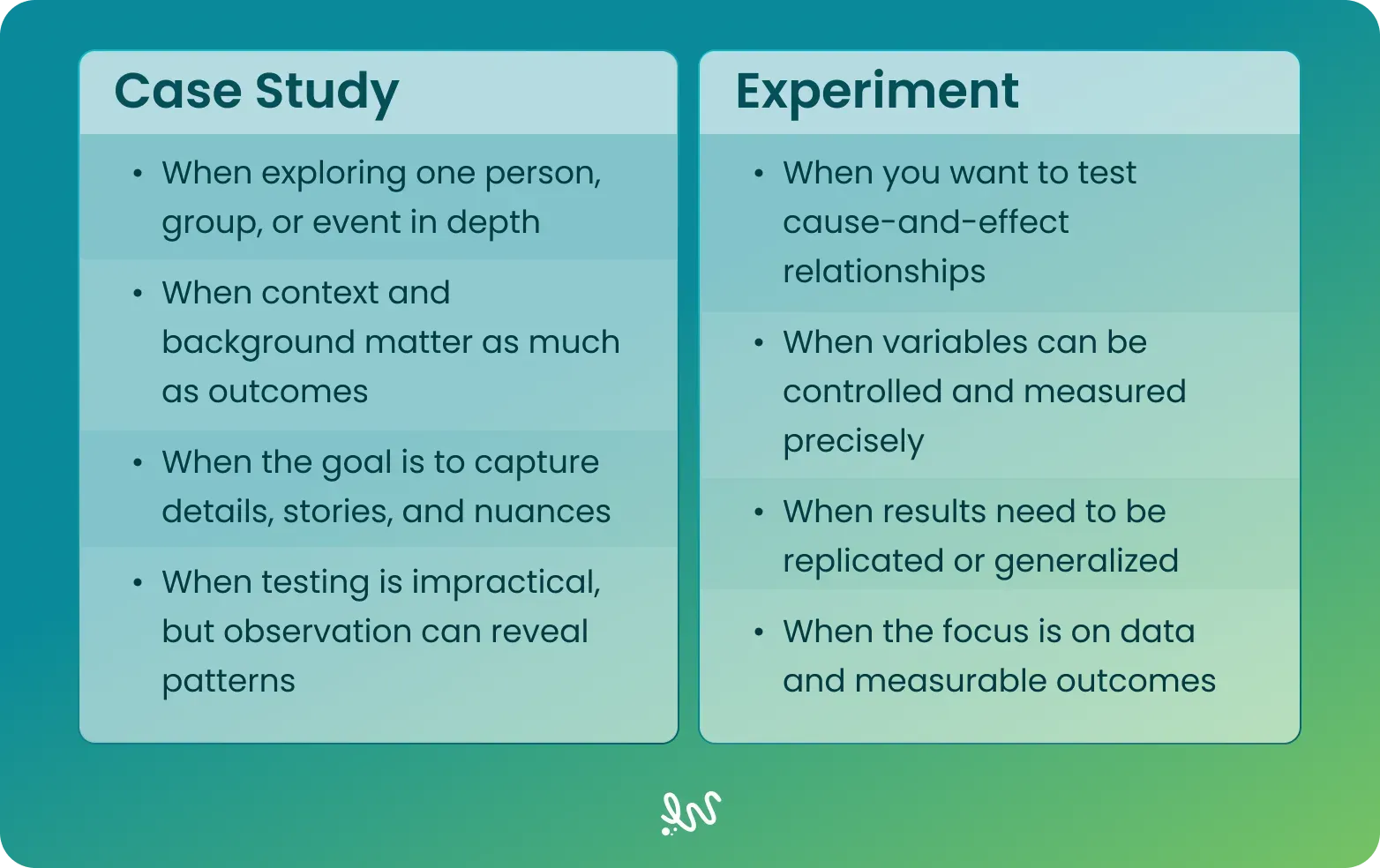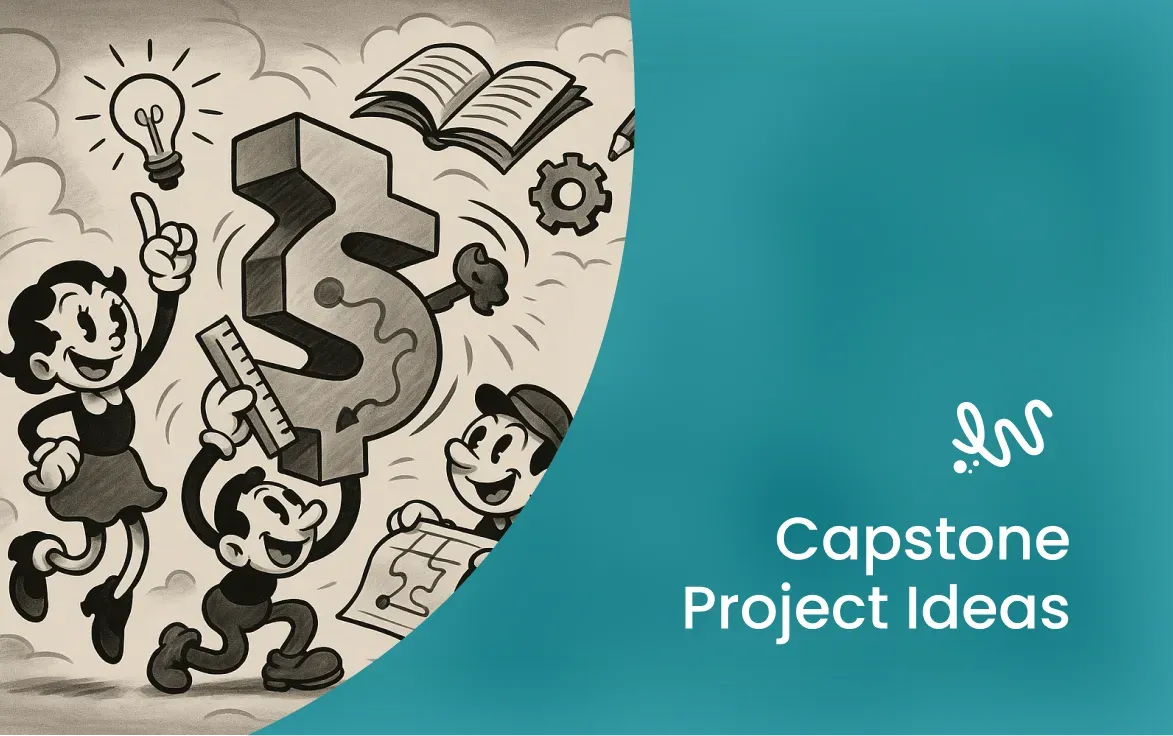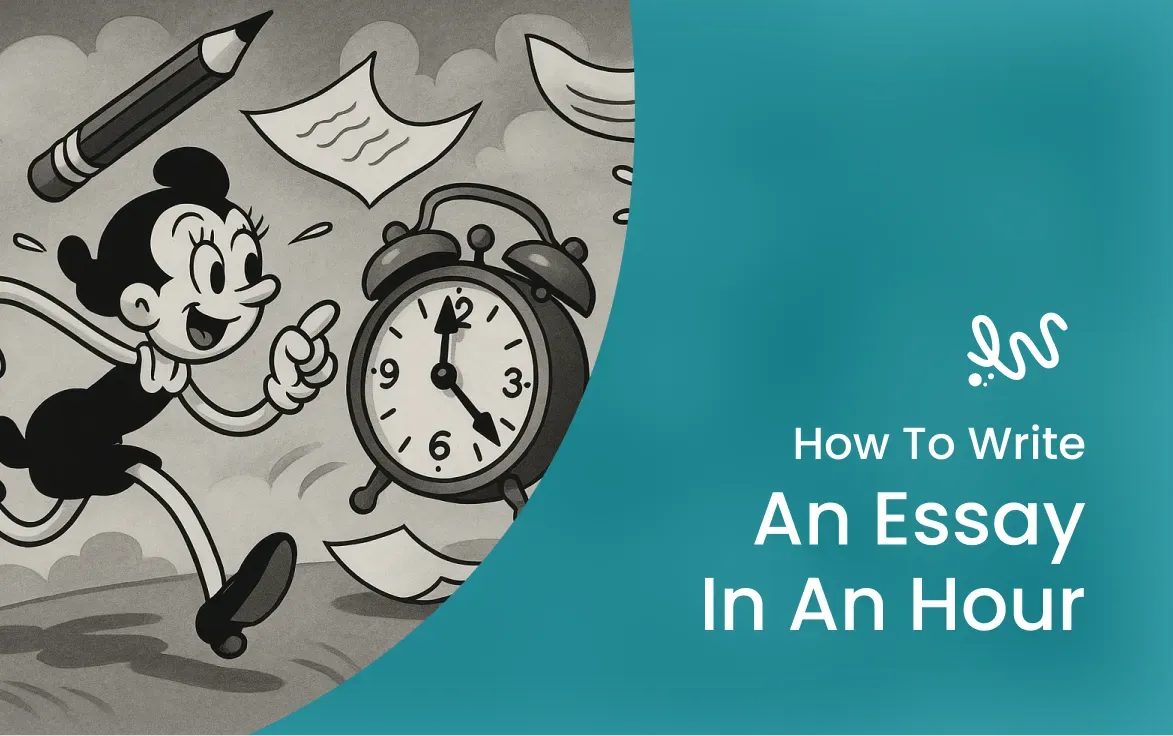A case study and experiment both answer research questions, but in different ways. A case study digs into a real life context where researchers gather information through archival records, document analysis, or observation methods to form a deep understanding of complex issues. An experiment, in contrast, sets up controlled conditions where independent variables are manipulated to test specific hypotheses.
In this article, we’ll look at the differences between case studies and experiments and explain when to use each. If by the end of this guide you still find yourself lost, simply ask WriteMyEssay to help with your assignments!
Case Study Feeling Overwhelming?
WriteMyEssay offers support for students who need help turning research data into strong academic work.
Write for Me
What Is a Case Study?
A case study is a research method that maps a particular case in its real life context to explain how naturally occurring variables interact. The case can be a person, a team, a school, or a city. Researchers observe what unfolds in real world phenomena without controlled manipulation.
Quantitative data comes from multiple sources. Organizational archives and archival records show decisions over time. Document analysis and content analysis reveal how language frames events. The observation method and the survey method capture social interactions as they naturally occur.
Together, these streams create qualitative insights and quantitative data that support a deep understanding of complex phenomena.
What Is an Experiment?
An experiment is a systematic approach that alters one or more variables under controlled conditions to test a specific hypothesis. Researchers assign people or units at random, manipulate the independent variable, and measure dependent variables with numerical data. Statistical analysis then estimates effects and the uncertainty around those effects.
Control is the signature of an experiment. Random assignment balances other variables across groups while controlled manipulation isolates the factor of interest. As for measures, they rely on quantitative research and produce empirical evidence that supports or rejects testing hypotheses. When the design blocks confound, results can establish causal relationships with clarity that other research methods rarely reach.
Difference Between Case Study and Experiment
Below are key differences between a case study and an experiment, focusing on purpose, variables, hypothesis, data usage, and implementation.
Aspect | Case Study | Experiment |
|---|---|---|
Purpose | Explore complex phenomena, generate qualitative insights, build or refine theories | Test specific hypotheses, establish causal relationships, provide empirical evidence |
Variables | Observed in natural settings without control | Manipulated under controlled conditions |
Hypothesis | May not begin with a fixed hypothesis; often generated during the study | Usually begins with a clear, testable hypothesis |
Data Usage | Relies on qualitative data from multiple sources such as interviews, documents, and archival records | Relies on quantitative data, numerical data, and statistical analysis |
Implementation | Widely used in social sciences to study complex issues and social processes | Common in psychology, biology, medicine, and other sciences requiring controlled manipulation |
Meanwhile, if you’re developing a case study, you’ll find valuable case study topic ideas in this resource.
Purpose
- Case studies seek to explain complex issues, generate actionable knowledge, and deepen understanding of human phenomena. They are well suited for exploratory research where the research question asks “how” or “why.”
- Experiments, in contrast, focus on testing hypotheses to establish causal mechanisms and confirm cause and effect relationships with empirical evidence.
Variables
- Case studies observe naturally occurring variables and examine how they interact within the case context. No controlled manipulation is applied.
- Experiments manipulate independent variables and measure dependent variables to identify cause and effect relationships.
Hypothesis
- Case studies may not start with a specific hypothesis. Instead, researchers gather information first and generate hypotheses based on patterns in the data.
- Experiments are designed around a specific hypothesis derived from existing theories or prior research.
Manipulating Variables
- In case studies, variables are not manipulated. Researchers instead focus on observing environmental factors and underlying factors that shape events.
- In experiments, variables are manipulated directly. Controlled manipulation lets researchers test one or more variables while holding other variables constant to establish causal relationships.
Data Usage
- Case studies often involve qualitative data and sometimes combine it with quantitative data. Sources include interviews, archival records, organizational archives, document analysis, or content analysis.
- Experiments depend on numerical data and statistical analysis to measure effects of manipulated variables, making the method strongly aligned with quantitative research.
Areas of Implementation
- Case studies appear most often in social sciences such as sociology, psychology, anthropology, and education.
- Experiments are central in disciplines like psychology, biology, medicine, and physics. These fields depend on random assignment, manipulated variables, and controlled environments to test specific hypotheses.
If you’re looking to strengthen overall research, here is a guide that covers practical ways to improve academic writing skills.
Deciding When to Use a Case Study or an Experiment

1. Use a case study for exploratory research, theory building, or when the research question asks how and why complex social processes unfold.
Case studies clarify underlying factors and possible causal mechanisms. They rarely establish causal relationships with the same force as a lab test, yet they generate actionable knowledge by identifying patterns, surfacing specific interventions, and refining existing theories.
The action research method fits naturally here, since a team can implement a change in a real life setting and study the effects in the same narrative.
Students who treat a case as a micro-history will see how human phenomena, historical events, and other variables mesh inside one coherent story.
2. Use experiments when the goal is to demonstrate cause-and-effect relationships or to evaluate specific interventions.
They are well suited for questions about performance, learning, or behavior under constraints. Qualitative data allows fine-grained checks for causal patterns. Replication across settings tests whether findings travel beyond the first lab.
When results hold across new samples and new contexts, the study vs field gap narrows and the evidence becomes strong enough to guide action.
Need Case Study Help Fast?
Don’t get stuck on research methods. Get help by WriteMyEssay and finish your project with confidence.
Get Help
Final Thoughts
Although both case studies and experiments test hypotheses and make sense of complex phenomena, they look at each research topic through completely different lenses. A case study works best when dealing with multiple sources, while an experiment thrives when you want controlled manipulation and random assignment. As we saw earlier, the choice depends on the research question.
Sometimes, the task feels overwhelming, but you don’t have to deal with it alone. Ask one of our authors at WriteMyEssay - write my case study for me, and we’ll take it from there!
FAQ
How Is a Case Study Different from an Experiment?
A case study looks at a real situation in detail and uses documents or interviews to see how variables interact. On the other hand, experiments change variables in controlled conditions and use numbers and statistics.
When Should I Use a Case Study Instead of an Experiment?
Use a case study when you want to explore complex issues and study people or groups in real settings, as well as build ideas from context rather than test them in a lab.
Can Case Study and Experiment Be Combined in Research?
Yes, some projects even combine a qualitative and quantitative research method. A case study can suggest ideas or questions, and an experiment can later test them in controlled conditions.
Sources
- McLeod, S. (2023). Case study method in psychology. Simply Psychology. https://www.simplypsychology.org/case-study.html
- National Research Council (US) Committee on Research in Education. (2002). Scientific research in education. National Academies Press (US). https://pmc.ncbi.nlm.nih.gov/articles/PMC3141799/
- Mertens, D. M. (2009). Research and evaluation in education and psychology: Integrating diversity with quantitative, qualitative, and mixed methods (3rd ed.). SAGE Publications. https://us.sagepub.com/sites/default/files/upm-binaries/24735_Chapter1.pdf



